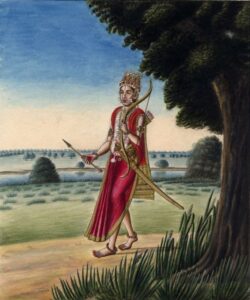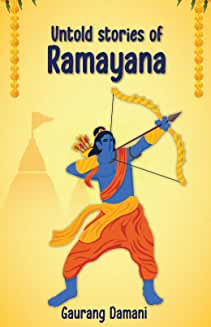
King Dasharatha had 3 wives viz. Kaushalya, Sumitra, and Kaikeyi. The wise Sumitra was a princess of Kashi. Dasharatha did not have a son who could take charge of his vast kingdom. During the time of his putreshti yagnya, the Deva-s (demigods) prayed to God Vishnu for relief from a wicked Rakshasa named Ravana. This giant cannibal terrorized the Deva-s, Brahmana-s, kings, and women. God Vishnu agreed to take an Avatara on Earth to provide relief from Ravana. He chose the radiant Dasharatha as his father. A divine entity appeared from the yagnya with payasam prasada. Dasharatha offered half its part to Kaushalya, a quarter to Sumitra, and 1/8th to Kaikeyi. Finally, he asked Sumitra to drink the remaining part of the drink. Rama was the eldest son born to Kaushalya. Kaikeyi gave birth to Bharata. From Sumitra, Lakshmana and Shatrughna were born.
Later as a youth, Rama lifted God Shiva’s celestial bow to win the hand of Seeta. It was also decided that Lakshmana would marry Seeta’a sister Urmila. King Janaka’s 2 nieces Mandavi and Shrutakirti married Bharata and Shatrughna respectively.
After Rama, Seeta, and Lakshmana went to the forest exile, Bharata tried his best to bring Rama back to Ayodhya. But Rama wanted to obey the wishes of his father and step-mother. Bharata decided to govern from Nandigrama on the outskirts of Ayodhya. Shatrughna coordinated the affairs of the state taking orders from Bharata.
14 years later, the news of Ravana’s killing and Rama’s arrival was conveyed to an ecstatic Bharata by Hanuman. Shatrughna decorated the highway from Nandigrama to Ayodhya and got the city roads washed with sandalwood water. Triumphant arches were erected. Shatrughna also arranged for barbers, baths, royal clothes, ornaments, and chariots before proceeding to the city.
After coronation, Rama performed an Ashwamedha yagnya wherein the ceremonial horse was followed by his army led by Shatrughna. Rama performed 10 such yagnya-s to become the Emperor of the World.
Later when Rama heard about a dhobi’s comments about Seeta, he called his 3 brothers in private. Rama asked if he should give up his life or leave Seeta. Shatrughna commented that the sun continues to shine even though the owls do not like him. But Rama wanted to perform his Raja dharma. When Lakshmana refused to kill Rama, he had to drop her at Valmiki’s ashrama.
A little later, Rishi-s Bhargava and Chyavana approached Rama for help against Lavanasura who killed ascetics on the banks of River Yamuna. Many monarchs had failed to subdue this tyrant in the Madhuvana forest. When Shatrughna volunteered for the job, Rama gave him a lethal celestial weapon.
En route, Shatrughna stopped at Maharishi Valmiki’s ashrama. That same night, Seeta gave birth to twins Kusha and Lava in the divine environment of the ashrama. Shatrughna experienced great delight when he heard of this good news. Proceeding further, he killed the merciless Rakshasa Lavanasura after a long deadly battle. The celestials and sages all showered praises on Shatrughna. He raised a picturesque city on the banks of River Yamuna, present-day Mathura in Uttar Pradesh state. It was filled with houses, shops, gardens, and wide streets. Crops filled all the fields again as it started raining in plentiful. After spending 12 years in his prosperous city, he decided to visit Ayodhya. During his return journey, he again stopped at Valmiki’s ashrama. Valmiki had taught Kusha and Lava the Vedic scriptures and weaponry. Shatrughna was happy to hear the residents chant a poem depicting Rama’s story. Valmiki advised Shatrughna not to disclose anything to Rama yet. He would do so at the right time.
During Rama’s another Ashwamedha yagnya, Shatrughna beheaded Ravana’s Rakshasa friend Vidyunmalin and his brother Ugramdamshtra. The ceremonial horse was captured by King Viramani of Devapura, a kingdom in the Vindhyas, but was defeated. God Shiva appeared to help his ardent devotee and fought many fierce battles. A distressed Shatrughna prayed to Rama for help. Rama came there and declared there is no difference between God Vishnu and God Shiva. Viramani returned the horse and decided to travel with the convoy.
The horse reached Valmiki’s ashrama on the banks of River Ganga. Lava tied it up and one after another, he defeated many stalwarts. Shatrughna realized that the child is the son of Seeta and Rama. He managed to make Lava unconscious after a long fight. An enraged Kusha then defeated Shatrughna. The humbled men returned to the yagnya site. Valmiki informed the assembly that they are Rama’s children. At Rama’s request, his 2 children and Seeta reached there. Seeta prayed to Bhoomidevi (Goddess Earth) to receive her if she is pure, and thus entered the earth.
When the planned period for Vishnu-avatara to spend on Earth was getting over, Lakshmana took jala samadhi (obstructing one’s breath underwater) on the banks of River Sarayu and merged with Adi Shesha. Bharata and Shatrughna decided to join Rama’s celestial journey. Shatrughna’s son Subahu succeeded him at Mathura. Shatrughna’s younger son Shrutaghati ruled Vidisha in present-day Madhya Pradesh state.
Rama moved towards the banks of River Sarayu to take jala samadhi. Bharata and Shatrughna and their respective wives, the ministers, Ayodhya’s citizens, Sugreeva, monkeys and bears also followed him.

This article is an excerpt from the book
‘Untold stories of Ramayana‘ by Gaurang Damani
This article also appeared on the Hindu Post website
